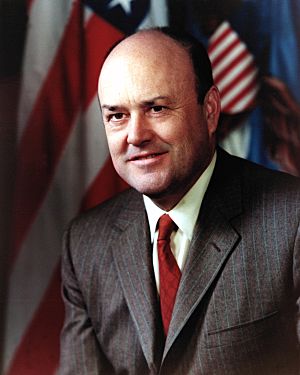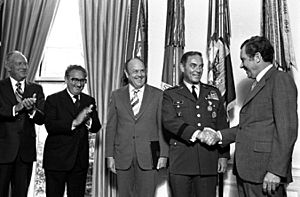Melvin Laird facts for kids
Quick facts for kids
Melvin Laird
|
|
|---|---|
 |
|
| White House Domestic Affairs Advisor | |
| In office May 1, 1973 – January 8, 1974 Acting: May 1, 1973 – June 6, 1973 |
|
| President | Richard Nixon |
| Preceded by | John Ehrlichman |
| Succeeded by | Kenneth Reese Cole Jr. |
| 10th United States Secretary of Defense | |
| In office January 22, 1969 – January 29, 1973 |
|
| President | Richard Nixon |
| Preceded by | Clark Clifford |
| Succeeded by | Elliot Richardson |
| Chair of the House Republican Conference | |
| In office January 3, 1965 – January 3, 1969 |
|
| Leader | Gerald Ford |
| Preceded by | Gerald Ford |
| Succeeded by | John B. Anderson |
| Member of the U.S. House of Representatives from Wisconsin's 7th district |
|
| In office January 3, 1953 – January 21, 1969 |
|
| Preceded by | Reid F. Murray |
| Succeeded by | Dave Obey |
| Personal details | |
| Born |
Melvin Robert Laird Jr.
September 1, 1922 Omaha, Nebraska, U.S. |
| Died | November 16, 2016 (aged 94) Fort Myers, Florida, U.S. |
| Resting place | Arlington National Cemetery |
| Political party | Republican |
| Spouses |
Barbara Masters
(m. 1942; died 1992)Carole Fleishman
(m. 1993) |
| Children | 4 |
| Education | Carleton College (BA) |
| Military service | |
| Branch/service | United States Navy |
| Years of service | 1942–1946 |
| Rank | Lieutenant (Junior Grade) |
| Battles/wars | World War II |
| Awards | Purple Heart |
Melvin Robert Laird Jr. (born September 1, 1922 – died November 16, 2016) was an important American politician. He served as a U.S. congressman for Wisconsin from 1953 to 1969. Later, he became the Secretary of Defense from 1969 to 1973 under President Richard Nixon.
Laird played a key role in the Vietnam War. He helped create the plan to bring U.S. soldiers home. He also created the term "Vietnamization." This meant giving more responsibility for fighting to the South Vietnamese forces.
Contents
Melvin Laird's Early Life and Education
Melvin Robert Laird was born in Omaha, Nebraska. His father, Melvin R. Laird Sr., was also a politician and businessman. Melvin grew up in Marshfield, Wisconsin, and later attended Lake Forest Academy in Illinois.
His family had a history in politics. His grandfather, William D. Connor, was the Lieutenant Governor of Wisconsin. His great-grandfather, Robert Connor, was a member of the Wisconsin State Assembly.
Military Service in World War II
Laird joined the United States Navy in 1943. He graduated from Carleton College in 1944. He served on a destroyer, the USS Maddox, in the Pacific Ocean during World War II. He received the Purple Heart medal for his service. Laird left the Navy in April 1946.
Melvin Laird's Political Career
Laird started his political career at a young age. He entered the Wisconsin State Senate when he was only 23. He took over his father's seat after his father passed away.
Serving in Congress
In 1952, Laird was elected to the United States House of Representatives. He represented Wisconsin's 7th District. This area included cities like Marshfield and Stevens Point. He was re-elected eight times, serving in Congress for 16 years.
Laird was known for his work on both domestic issues (things happening in the U.S.) and defense. He was the chairman of the House Republican Conference when President Nixon chose him for the cabinet. He supported a strong national defense.
Laird voted for important laws like the Civil Rights Act of 1964. This law helped end discrimination. He also supported the Voting Rights Act of 1965, which protected the right to vote for all citizens.
Secretary of Defense
Melvin Laird became the United States Secretary of Defense on January 22, 1969. He served in this role for four years. As Secretary of Defense, he worked to improve the Department of Defense. He appointed a special panel that made many suggestions for how the department could work better.

Ending the Vietnam War
Laird played a very important part in the Vietnam War. He helped create the plan to bring U.S. troops home. He called this plan "Vietnamization." This meant training and equipping the South Vietnamese army to take over the fighting. This way, American soldiers could gradually leave.
Laird also worked hard to bring home American prisoners of war (POWs) held in North Vietnam.
Military Changes and the Draft
Laird wanted to end the military draft. The draft made it mandatory for young men to serve in the military. He worked towards creating an All Volunteer Force (AVF). This meant people would choose to join the military instead of being forced to.
The number of people drafted went down during his time. On January 27, 1973, Laird stopped the draft completely. This was five months earlier than planned.
Later Career and Legacy
Laird finished his term as Secretary of Defense on January 29, 1973. He had always said he would only serve for four years. After leaving the Pentagon, he returned to the Nixon administration in June 1973. He became a special advisor to the president on domestic issues.
Laird was well-respected even during the Watergate scandal. He had good relationships with military leaders and Congress. This helped him get support for his plans and budget requests.
In 1974, he received the Presidential Medal of Freedom. This is one of the highest awards a civilian can receive in the U.S. He also wrote articles for Reader's Digest and other publications.
Laird was quietly against the 2003 invasion of Iraq. He tried to convince President George W. Bush not to invade.
Contributions to Health Care Research
Melvin Laird also played a big role in helping medical research. This part of his life is often not as well known as his political work.
As a congressman, he worked with other politicians to pass laws about health care. They helped expand health research programs and facilities. They supported the growth of the National Library of Medicine and the Centers for Disease Control (CDC). They also helped create the nation's eight National Cancer Centers.
Laird received many awards for his work in health. These included the Albert Lasker Medical Research Award in 1964. He was also a member of the U.S. Delegation to the World Health Organization in Geneva, Switzerland. Three different U.S. presidents appointed him to this role.
President Dwight D. Eisenhower admired Laird's work so much that he called him "one of the 10 men best qualified to become President of the United States."
Death and Honors
Melvin Laird passed away on November 16, 2016, at the age of 94. He died in Fort Myers, Florida.
Secretary of Defense Ash Carter said that Laird "demonstrated an unfailing commitment to protecting our country." Senator John McCain also praised Laird, especially for his work in Vietnam.
The Laird Center for Medical Research in Marshfield, Wisconsin, is named after him. It is a medical research and education center. Laird was buried in Arlington National Cemetery.
Images for kids
-
Secretary of Defense Melvin R. Laird with Air Force Chief of Staff General John D. Ryan and Secretary of The Air Force Robert C. Seamans at a ceremony in The Pentagon.
-
Melvin Laird meets with successor as Secretary of Defense, Elliot Richardson at his office in The Pentagon, December 18, 1972.
-
Secretary of Defense Melvin Laird meets with Chairman of The Joint Chiefs of Staff Admiral Thomas Moorer and the other members of The Joint Chiefs of Staff in his Pentagon office.
-
Secretary of Defense Melvin Laird with President Richard Nixon and Secretary of The Navy John Warner present Congressman Carl Vinson with a model of aircraft carrier U.S.S. Carl Vinson at Andrews Air Force Base, November 18, 1973.
-
Laird (left) with one of his successors, Donald Rumsfeld, and biographer Dale Van Atta, 2001.
See also
 In Spanish: Melvin Laird para niños
In Spanish: Melvin Laird para niños






